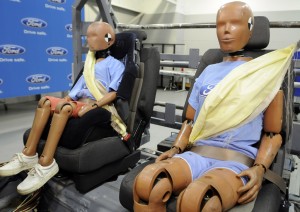Seats that can monitor your heart or warn of an impending diabetic attack; vehicles that chat with each other – and with stoplights – Ford Motor Co. lifted its kimono this week to reveal an array of high-tech systems the Detroit maker hopes will help position it as an industry leader.
The challenge is significant, however, in the world of digital, in-car technology. Where a breakthrough powertrain or vehicle design might give a maker a several-year lead, it’s much more difficult to stay ahead in terms of electronics – as Ford is discovering now that most of its key competitors are taking aim at its popular Sync system.
Ford invited journalists to its Dearborn headquarters this week to show of the latest and greatest innovations now under development, starting with Sync. Ford is tweaking its voice-operated system to make it more user-friendly, adding bigger on-screen fonts and improving software and voice recognition.
The company also is adding the Sync Applink system, which allows drivers to use Sync to control their smartphone apps. It till debut in 10 Ford-branded vehicles for 2012, the Mustang, Fusion/Fusion Hybrid, Fiesta, F-150, F-150 SVT Raptor, Super Duty, Expedition, E-Series, and Shelby GT500.
Ford is also expanding the use of inflatable rear seat belts, first seen in the 2011 Explorer, to the Flex crossover and two new (and as yet unidentified) Lincolns.
While the changes to Sync and the addition of Applink—along with the addition of the inflatable rear seat belts to certain models—will be apparent in the short term, Ford has other tricks up its technology sleeve.
For instance, the company is working on developing vehicles that can talk to each other—and to stoplights—using wi-fi signals. The goal here is to give drivers a warning before an impending collision, by having the cars talk to each other, thus knowing where they are in relation to each other on the road. The system can also “look” around corners when the view is blocked.
Ford also showed off a seat with a built-in heart-rate monitor which could be used to track a driver’s stress level, causing the vehicle’s driving dynamics to adjust to the situation. Another app from the future could detect pollen counts and direct drivers with allergies around smoggy areas, while yet another can keep an eye on diabetic drivers’ blood-sugar levels. Finally, a “Sync My Brain” app could be used to quiz drivers and passengers about trivia on long road trips.
Among more current features, Ford’s MyKey system, which parents can use to limit their teen drivers’ access to certain features, now has a feature in which the radio won’t play if the seat belts aren’t buckled.
Aware of complaints from some users that Sync’s voice recognition system sometimes leaves a lot to be desired, Ford is working on improving the system so that it does a better job determining a user’s intent and then performing the specific action that the user asks for without forcing the motorist to learn a series of rigid commands.
Finally, the increase in font size is meant to make driving easier for those over the age of 60—a category that will grow quickly as the Baby Boomer generation ages.
While some of what Ford showed off is still in development, it’s clear that the company is looking to tech to help it stand out from its competitors.

